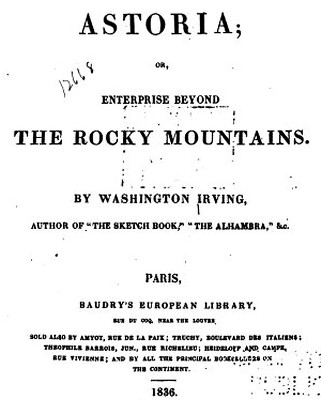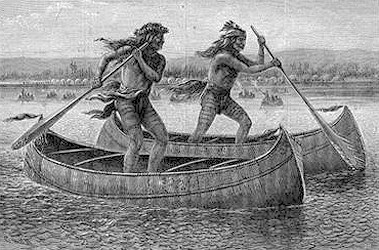
washington irving : columbia river canoes, 1836
| home | catalogue | history | references | appendix |
 |
surfresearch.com.au
washington irving : columbia river canoes, 1836 |
Internet Archive
http://archive.org/details/astoriaorenterp02irvigoog
While this quotation
demonstrates considerable canoeing skills, the text is somewhat unclear
whether the "waves" are swell at sea or waves in the surf-zone, and it
is unclear if the report specically details wave riding.
However, on 26th
August 1912, the Tacoma Times reported a group of day-vistitors
traveled on the Northern Pacific Railway to Moclips Beach in Washington
where the various entertainments included "surf riding by the Quinalt (sic)
Indians."
The Quinault Indians
had developed a high degree of skill with canoes carved from cedar trees
in a variety of specialized designs adapted to
rivers, estuaries,
and the sea.
Moclips may be a
variation of the Quinault No-mo-Klopish, meaning “people of the
turbulent water.”
Also see:
1815 Peter Corney
: Hawai'i and Columbia River.
1835 Rev. Samuel
Parker : Native Canoe at
Columbia River.
1868 Gilbert Sproat : Canoe
Riders of Vancouver Island.
Unfortunately, there
appears to be no accounts of the maritime skills of the native inhabitants
of California, their culture coming under severe pressure with the arrival
of Spanish missionaries in 1697.
By 1820 Spanish
influence was marked by the chain of missions occupying a 25 mile wide
coastal zone between Loreto, north to San Diego, to just north of today's
San Francisco.
-Wikipedia: History
of California to 1899, viewed 14 June 2013.
http://en.wikipedia.org/wiki/History_of_California_to_1899
There is substantial archeological evidence indicating that the Americas were intially occupied by coastal migration (known as the coastal migration theory), and ancient occupation of the off-shore islands by the coastal tribes of California necessitated the use of sea-going canoes and employed considerable maritime skills.
"Archaeological research has shown that San Miguel Island was first
settled by humans at least 12,000 years ago, in the Millingstone Horizon
archaeological period.
Because the northern Channel Islands have not been connected to the
adjacent mainland in recent geological history, the Paleo-Indians who first
settled the island clearly had boats and other maritime technologies.
Rough seas and risky landings did not daunt the Chumash people.
They called the island Tuquan in the Chumash language, and for several
centuries, they used plank-built canoes, called tomols, to reach their
settlements."
-Wikipedia: San
Migel Island- History, viewed 14 June 2013.
http://en.wikipedia.org/wiki/San_Miguel_Island
For a recent compliation of scientific artcles supporting coastal migration
theory, with some work in California, see:
Bicho, Haws, and Davis (editors): Trekking
the Shore- Changing Coastlines and the Antiquity of Coastal Settlement
(2011).
Herve also attached
two illustrations to his post.
The first,
W. de la Montagne Cary's Indian Canoe Race, published by Harper’s
Weekly in 1874, illustrates a paddling-while-standing technique
in bark-canoes.
The second is Los
Indians de Pacifique, drawn by G. D’Antonio for the cover of a French
educative comic book, Histoire du Far West, published in 1982.
In this fanciful
represenation, a native prepares to launch his spear-harpoon while the
crew ster the canoe on a considerable wave.
Reproduced below.
The natives inhabiting
the lower part of the [Columbia River] river, and with whom the company
was likely to have the most frequent intercourse, were divided at this
time into four tribes, the Chinooks, Clatsops, Wahkiacums, and Cathlamahs.
They resembled
each other in person, dress, language, and manner; and were probably from
the same stock, but broken into tribes, or rather hordes, by those feuds
and schisms frequent among Indians.
These people generally
live by fishing. It is true they occasionally hunt the elk and deer, and
ensnare the waterfowl of the ponds and rivers, but these are casual Iu;[uries.
Their chief subsistence
is derive from the salmon and other fish which abound in the Columbia and
Page 50 [BOLD NAVlGATORS.]
its tributary streams, aided by roots and herbs, especially the wappaioo, which is found on the islands of the rirer.
As the Indians of the plains who depend upon the chase are bold and expert riders, and pride themselves upon their horses, so these piscatory tribes of the coast excel in the management of canoes, and are never more at home than when riding upon the waves. (..)
Their canoes vary
In form and size.
Some are upwards
of fifty feet long, cutout of a single tree, either fir of white cedar,
and capable of carrying thirty persons.
They have thwart
pieces from side to side about three inches thick, and their gunwales flare
outwards, so as to cast off the surges of the waves.
The bow and stern
are decorated with grotesque figures of men and animals^ sometimes five
feet in height.
In managing their
canoes they kneel two and two along the bottom, sitting on their heels,
and wielding paddles from four to five feet long, while one sits on the
stern and steers with a paddle of the same kind.
The women are
equally expert with the men in managing the canoe, and generally take the
helm.
It is surprising
to see with what fearless unconcern these savages venture in their light
barks upon the roughest and most tempestuous seas.
They seem to
ride upon the waves like seafowl.
Should a surge
throw the canoe upon its side and endanger its overturn, those to windward
lean over the upper gunwale, thrust their paddles deep into the wave, apparently
catch the water and force it under the canoe, and by this action not merely
regain an equilibrium, but give their bark a vigorous impulse forward.
 |
Astoria ; or Enterprise Beyond the Rocky Mountains. ,1836. Internet Archive
|
 |
W. de la Montagne Cary: Indian Canoe Race. Harper’s Weekly, 1874). Right:
Cover of a French educative comic book, Histoire du Far West, 1982. Images forwarded
by
|
 |

| home | catalogue | history | references | appendix |